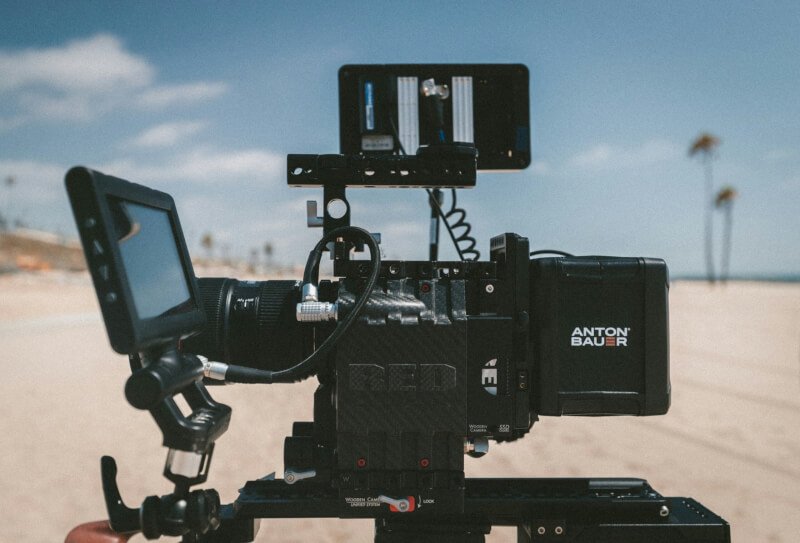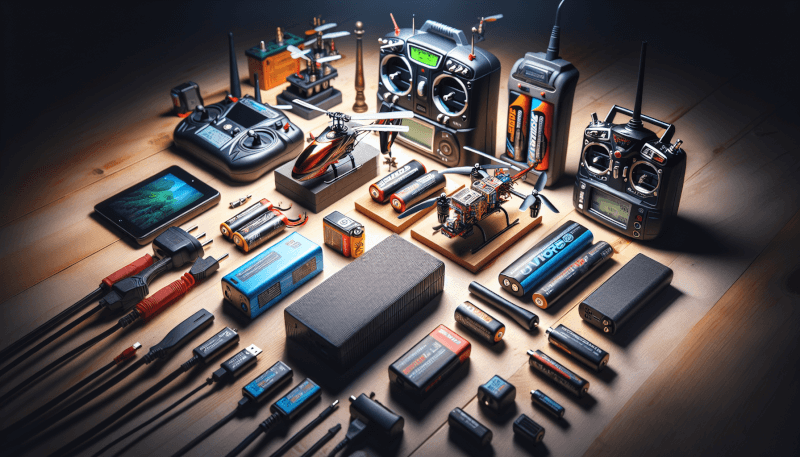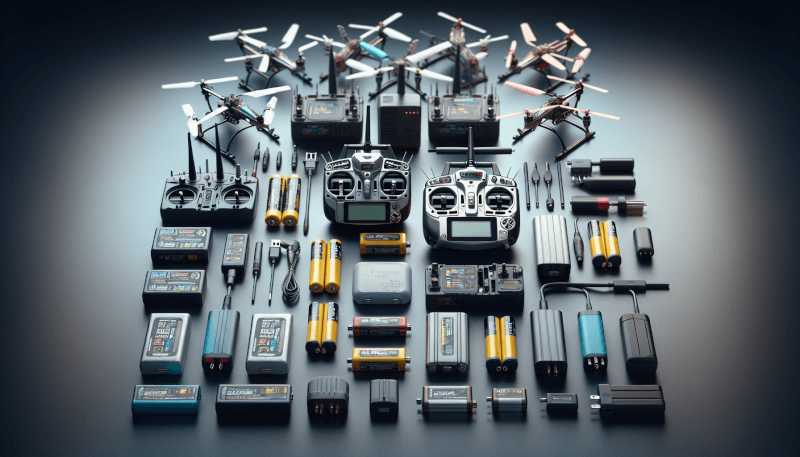In this article, you will gain a comprehensive understanding of the various types of RC heli batteries and chargers available in the market. Whether you are a novice or an experienced RC heli enthusiast, knowing which battery and charger work best for your helicopter is crucial for optimal performance and prolonged battery life. From the traditional Nickel-Cadmium (NiCd) batteries to the modern Lithium Polymer (Li-Po) batteries, you will discover the strengths and weaknesses of each option, as well as important charging considerations. So, sit back, relax, and let’s explore the world of RC heli batteries and chargers together.

Types of RC Heli Batteries
When it comes to choosing the right battery for your RC helicopter, there are three main types to consider: Lithium Polymer (LiPo) batteries, Nickel-Metal Hydride (NiMH) batteries, and Nickel-Cadmium (NiCd) batteries.
Lithium Polymer (LiPo) Batteries
LiPo batteries have become the standard choice for many RC helicopter enthusiasts due to their high energy density and lightweight design. These batteries offer several advantages over other types, but they also have a few disadvantages to consider.
Advantages of LiPo Batteries
One of the major advantages of LiPo batteries is their high energy density. This means they can store a large amount of energy in a compact size, allowing you to fly your RC helicopter for longer periods of time without needing to recharge. LiPo batteries also have a low self-discharge rate, which means they can hold their charge for longer periods when not in use.
Another advantage of LiPo batteries is their high discharge rate. This allows them to deliver a surge of power when needed, making them ideal for high-performance RC helicopters that require quick acceleration and maneuverability. Additionally, LiPo batteries have a wide range of available sizes and capacities, giving you more options to choose from based on your specific needs.
Disadvantages of LiPo Batteries
While LiPo batteries offer many benefits, they also come with a few drawbacks. One of the main concerns with LiPo batteries is their sensitivity to mishandling or improper charging. LiPo batteries require careful charging and storage procedures to prevent overheating, swelling, or even catching fire. It is important to use a LiPo-specific charger and follow the manufacturer’s instructions for charging and handling the battery.
Another disadvantage of LiPo batteries is their relatively short lifespan compared to other battery types. Over time, the capacity of a LiPo battery will diminish, leading to shorter flight times. However, with proper care and maintenance, you can maximize the lifespan of your LiPo batteries.
Charging and Safety Precautions for LiPo Batteries
To ensure the safety and longevity of your LiPo batteries, it is crucial to follow proper charging and safety precautions. Always use a dedicated LiPo charger designed to balance the cells and prevent overcharging. Additionally, it is essential to never leave LiPo batteries unattended while charging and to store them in a fireproof LiPo safety bag or container. Regularly check your LiPo batteries for any signs of damage or swelling and dispose of them properly if they become damaged or reach the end of their lifespan.
Nickel-Metal Hydride (NiMH) Batteries
NiMH batteries have been widely used in RC helicopters for many years. They offer a good balance between performance, affordability, and ease of use. Let’s explore the advantages and disadvantages of NiMH batteries.
Advantages of NiMH Batteries
One of the main advantages of NiMH batteries is their affordability. Compared to LiPo batteries, NiMH batteries are generally more cost-effective, making them a popular choice for beginners and hobbyists on a budget. NiMH batteries also have a longer cycle life, meaning they can be charged and discharged more times before their capacity starts to significantly decrease.
Another advantage of NiMH batteries is their ease of use. Unlike LiPo batteries, NiMH batteries don’t require as much care during charging and storage. They are less sensitive to mishandling and can be safely charged using a standard charger without the need for a balance charger.
Disadvantages of NiMH Batteries
While NiMH batteries offer affordability and ease of use, they do have some drawbacks to consider. One of the main disadvantages is their lower energy density compared to LiPo batteries. This means that NiMH batteries are generally heavier and bulkier for the same capacity, which can impact the flight performance of your RC helicopter.
Another disadvantage of NiMH batteries is their lower discharge rate. They may not provide the same level of power and acceleration as LiPo batteries, which can affect the overall performance of your RC helicopter. Additionally, NiMH batteries have a higher self-discharge rate, meaning they lose their charge over time even when not in use.
Charging and Safety Precautions for NiMH Batteries
To effectively charge and maintain your NiMH batteries, it is recommended to use a charger specifically designed for NiMH batteries. Avoid overcharging or discharging the batteries beyond their recommended limits. It is also important to store NiMH batteries in a cool and dry place, away from direct sunlight or extreme temperatures. Regularly monitor the condition of your NiMH batteries and replace them when their capacity significantly declines.
Nickel-Cadmium (NiCd) Batteries
NiCd batteries were once a popular choice for RC helicopters, but their usage has declined over the years due to advancements in battery technology. However, it is still worth discussing their advantages and disadvantages for those who may still be using them.
Advantages of NiCd Batteries
NiCd batteries have a long history in the RC helicopter community and offer a few advantages. One of the main advantages is their robust construction, which allows them to withstand heavy use and abuse. They can handle high discharge rates and are less prone to damage from overcharging or deep discharging.
Another advantage of NiCd batteries is their ability to perform well in extreme temperatures. They can tolerate both high and low temperatures better than other battery types, making them suitable for flying in various weather conditions. NiCd batteries also have a longer shelf life compared to NiMH and LiPo batteries, meaning they can hold their charge for longer periods when not in use.
Disadvantages of NiCd Batteries
Despite their advantages, NiCd batteries have significant drawbacks that led to their decline in popularity. One of the main disadvantages is their heavy weight and bulkiness for the same capacity compared to other battery types. This can limit the flight performance and agility of your RC helicopter.
Another disadvantage of NiCd batteries is their toxic composition. They contain cadmium, a harmful heavy metal, which makes them more environmentally unfriendly compared to other battery types. NiCd batteries also suffer from the “memory effect,” which means that if they are not fully discharged and charged regularly, their capacity can decrease over time.
Charging and Safety Precautions for NiCd Batteries
When charging NiCd batteries, it is important to use a charger specifically designed for NiCd batteries to prevent overcharging. Avoid deep discharging NiCd batteries as it can lead to a reduced capacity. NiCd batteries should also be stored in a cool and dry place, away from direct sunlight and extreme temperatures. Proper disposal of NiCd batteries is essential to prevent environmental contamination, so be sure to follow local regulations for battery disposal.
Chargers for RC Heli Batteries
Choosing the right charger for your RC helicopter batteries is just as important as selecting the correct battery type. There are several types of chargers available, each with its own features and benefits. Let’s explore some popular charger options.
Balance Chargers
Balance chargers are specifically designed for LiPo batteries. They ensure that each individual cell within the battery pack is charged to the same voltage, maximizing the lifespan and performance of the battery. Balance chargers typically feature advanced charging algorithms and safety features to prevent overcharging or undercharging.
Peak Detectors
Peak detectors are commonly used for NiMH and NiCd batteries. They detect the peak voltage of the battery during charging and automatically stop the charging process when the battery is fully charged. This helps prevent overcharging and extends the lifespan of the battery.
Trickle Chargers
Trickle chargers provide a low, constant current to the battery, slowly and continuously charging it over an extended period. They are often used for NiMH and NiCd batteries and are suitable for long-term storage charging or maintaining the battery’s charge when it is not in use.
Fast Chargers
As the name suggests, fast chargers offer quick charging times, allowing you to charge your batteries rapidly. They are commonly used for LiPo batteries and feature high charging rates. However, it is essential to follow the manufacturer’s recommendations and safety precautions when using fast chargers to prevent overheating or damaging the battery.

Balance Chargers
Balance chargers are a popular choice for those using LiPo batteries in their RC helicopters. These chargers ensure that each individual cell within the battery pack is charged to the same voltage, maximizing the performance and lifespan of the battery.
Features and Benefits of Balance Chargers
One of the key features of balance chargers is their ability to monitor and balance the voltage of each cell in a LiPo battery pack. This helps prevent cell imbalances, which can lead to reduced performance, heating, and potentially even damage.
Balance chargers also typically come with advanced charging algorithms that analyze the battery’s condition and adjust the charging process accordingly. This helps optimize the charging time and ensures that the battery is charged to its maximum capacity while maintaining safety.
Another benefit of balance chargers is their safety features. They often include features such as overcharging protection, short-circuit protection, and temperature monitoring to prevent any potential hazards during the charging process.
How to Use a Balance Charger
Using a balance charger is relatively straightforward. First, connect the charger to a power source and then connect the LiPo battery to the charger. Make sure to correctly align the battery’s positive and negative terminals with the charger’s corresponding connectors.
After the battery and charger are connected, you can select the appropriate charging settings on the charger, such as voltage and current. It is crucial to input the correct settings based on the battery’s specifications to prevent overcharging or undercharging.
Once the settings are configured, start the charging process. The balance charger will monitor and balance the voltage of each cell within the battery pack, ensuring an even charge. It is important to regularly monitor the charging process and keep an eye on any safety warnings or indications from the charger.
After the battery is fully charged, disconnect it from the charger and safely store or use it as needed. Always ensure that the battery is charged and handled with care to minimize any potential risks.
Peak Detectors
Peak detectors are commonly used for charging NiMH and NiCd batteries. These chargers detect the peak voltage of the battery during charging and automatically stop the charging process when the battery is fully charged.
Features and Benefits of Peak Detectors
One of the main features of peak detectors is their ability to accurately detect the peak voltage of the battery. This ensures that the battery is not overcharged, which can lead to reduced performance and potentially damage the battery over time.
Peak detectors also often feature a simple and user-friendly design, making them easy to use even for beginners. They typically have a clear indicator that shows the charging progress and alerts you when the battery is fully charged.
Additionally, peak detectors are relatively affordable compared to some other types of chargers, making them a popular choice for those on a budget.
How to Use a Peak Detector
Using a peak detector charger is simple and straightforward. Start by connecting the charger to a power source and then connect the NiMH or NiCd battery to the charger. Ensure that the positive and negative terminals of the battery align correctly with the charger’s connectors.
Next, select the appropriate charging settings on the peak detector charger. These settings will vary depending on the specifications of your specific battery, so refer to the manufacturer’s instructions for the correct input values.
After configuring the settings, start the charging process. The peak detector charger will continuously monitor the voltage of the battery and automatically stop the charging process when the battery reaches its peak voltage.
Once the charging process is complete, disconnect the battery from the charger and safely store or use it as needed. Always follow safety precautions and handle the charged battery with care.

Trickle Chargers
Trickle chargers provide a low and continuous current to the battery, slowly charging it over an extended period. They are commonly used for NiMH and NiCd batteries and are suitable for long-term storage charging or maintaining the battery’s charge when it is not in use.
Features and Benefits of Trickle Chargers
One of the main features of trickle chargers is their slow and steady charging rate. They charge the battery at a low current, which helps prevent overcharging and reduces the risk of damaging the battery.
Trickle chargers also often have built-in safety features to monitor the charging process. They may include features such as automatic shutoff, short-circuit protection, and temperature monitoring to ensure safety during the charging process.
Another benefit of trickle chargers is their versatility. They can be used for various battery types, including NiMH and NiCd, making them a convenient option for those who have multiple RC helicopters with different battery types.
How to Use a Trickle Charger
Using a trickle charger is simple and convenient. Start by connecting the charger to a power source and then connect the battery to the charger. Ensure that the positive and negative terminals of the battery align correctly with the charger’s connectors.
Once the charger and battery are connected, you can turn on the charger to start the trickle charging process. Trickle chargers typically have a slow charging rate, so it may take several hours or even days to fully charge the battery, depending on its capacity and current charge level.
During the charging process, it is important to regularly monitor the battery and charger for any signs of overheating or other safety concerns. If any issues arise, it is recommended to disconnect the battery from the charger and assess the situation before continuing the charging process.
Once the battery is fully charged, disconnect it from the trickle charger and safely store or use it as needed. Remember to handle the charged battery with care and follow proper safety precautions.
Fast Chargers
Fast chargers are designed to provide quick charging times, allowing you to charge your RC helicopter batteries rapidly. They are commonly used for LiPo batteries and often feature high charging rates. However, it is crucial to follow the manufacturer’s recommendations and safety precautions when using fast chargers to prevent overheating or damaging the battery.
Features and Benefits of Fast Chargers
One of the main features of fast chargers is their high charging rate. They can deliver a significant amount of current to the battery, allowing you to charge it quickly and get back to flying your RC helicopter. Fast chargers are especially favored by competitive RC helicopter pilots who require minimal downtime between flights.
Fast chargers also often come with advanced charging algorithms and safety features to prevent overcharging and protect the battery. Many fast chargers have temperature monitoring capabilities to ensure that the battery does not overheat during the charging process.
Additionally, some fast chargers offer compatibility with multiple battery types, allowing you to charge different batteries using the same charger. This versatility can be convenient for those who own multiple RC helicopters with different battery requirements.
How to Use a Fast Charger
Using a fast charger requires caution and careful attention to safety guidelines. Start by connecting the charger to a power source and then connect the battery to the charger. Ensure that the positive and negative terminals of the battery align correctly with the charger’s connectors.
Before starting the charging process, it is crucial to review the manufacturer’s instructions and recommendations for the specific fast charger you are using. Each fast charger may have different charging settings or parameters that need to be configured to match the battery’s requirements.
Once the charging settings are properly configured, you can start the fast charging process. Monitor the charging progress closely and be aware of any safety warnings or precautions provided by the charger or battery manufacturer.
It is important to note that fast chargers can generate a significant amount of heat during the charging process. To prevent overheating, ensure that the charger and battery have proper ventilation and that they are placed on a non-flammable surface away from any combustible materials.
After the battery is fully charged, disconnect it from the fast charger and safely store or use it as needed. Always handle the charged battery with care and follow all safety guidelines provided by the manufacturer.

Factors to Consider when Choosing RC Heli Batteries and Chargers
When selecting RC helicopter batteries and chargers, it is essential to consider several factors to ensure optimal performance and safety. Here are some key factors to keep in mind:
Battery Capacity
The capacity of the battery refers to the amount of energy it can store. Higher capacity batteries typically allow for longer flight times but may be heavier and bulkier. Consider your specific flying style and needs to determine the appropriate battery capacity for your RC helicopter.
Voltage
The voltage of the battery should match the voltage requirements of your RC helicopter. Using a battery with the wrong voltage can lead to performance issues or potential damage. Refer to your helicopter’s manual or consult with an expert to determine the correct voltage requirements.
Weight and Size
The weight and size of the battery can affect the overall performance and flight characteristics of your RC helicopter. Heavier batteries may limit maneuverability and agility, while larger batteries may not fit properly within the helicopter’s designated battery compartment. Consider the weight and size limitations of your helicopter when choosing a battery.
Compatibility
Ensure that the battery and charger you select are compatible with your RC helicopter and other electronic components. Check the connectors and specifications of the battery and charger to ensure a proper fit and compatibility.
Charging Time
Consider the charging time required by the battery and charger. Some batteries may take longer to charge than others, especially with trickle chargers. Fast chargers can reduce charging time significantly, but be cautious of their potential impact on battery lifespan and safety.
Budget
Lastly, consider your budget when choosing RC helicopter batteries and chargers. LiPo batteries and advanced chargers tend to be more expensive due to their high-performance capabilities. If you are a beginner or on a limited budget, NiMH batteries and basic chargers may be more suitable options.
By carefully considering these factors, you can select the right batteries and chargers that meet the specific needs of your RC helicopter, ensuring a safe and enjoyable flying experience.


